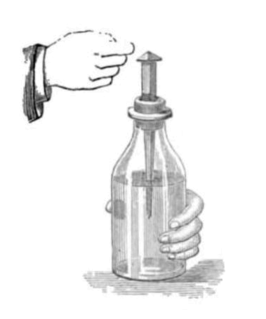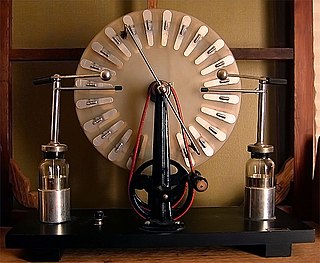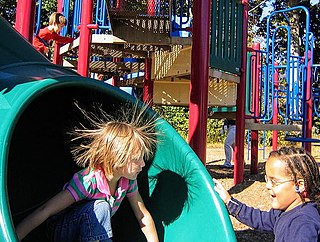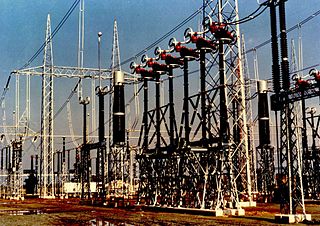
A Leyden jar is an electrical component which stores a high-voltage electric charge between electrical conductors on the inside and outside of a glass jar. It typically consists of a glass jar with metal foil cemented to the inside and the outside surfaces, and a metal terminal projecting vertically through the jar lid to make contact with the inner foil. It was the original form of the capacitor.

A Van de Graaff generator is an electrostatic generator which uses a moving belt to accumulate electric charge on a hollow metal globe on the top of an insulated column, creating very high electric potentials. It produces very high voltage direct current (DC) electricity at low current levels. It was invented by American physicist Robert J. Van de Graaff in 1929. The potential difference achieved by modern Van de Graaff generators can be as much as 5 megavolts. A tabletop version can produce on the order of 100 kV and can store enough energy to produce visible electric sparks. Small Van de Graaff machines are produced for entertainment, and for physics education to teach electrostatics; larger ones are displayed in some science museums.

Electrostatic discharge (ESD) is a sudden and momentary flow of electric current between two electrically charged objects caused by contact, an electrical short or dielectric breakdown. A buildup of static electricity can be caused by tribocharging or by electrostatic induction. The ESD occurs when differently-charged objects are brought close together or when the dielectric between them breaks down, often creating a visible spark.

Capacitance is the ratio of the amount of electric charge stored on a conductor to a difference in electric potential. There are two closely related notions of capacitance: self capacitance and mutual capacitance. Any object that can be electrically charged exhibits self capacitance. In this case the electric potential difference is measured between the object and ground. A material with a large self capacitance holds more electric charge at a given potential difference than one with low capacitance. The notion of mutual capacitance is particularly important for understanding the operations of the capacitor, one of the three elementary linear electronic components. In a typical capacitor, two conductors are used to separate electric charge, with one conductor being positively charged and the other negatively charged, but the system having a total charge of zero. The ratio in this case is the magnitude of the electric charge on either conductor and the potential difference is that measured between the two conductors.

The Wimshurst influence machine is an electrostatic generator, a machine for generating high voltages developed between 1880 and 1883 by British inventor James Wimshurst (1832–1903).

Static electricity is an imbalance of electric charges within or on the surface of a material or between materials. The charge remains until it is able to move away by means of an electric current or electrical discharge. Static electricity is named in contrast with current electricity, where the electric charge flows through an electrical conductor or space, and transmits energy.

An electrophorus or electrophore is a simple manual capacitive electrostatic generator used to produce electrostatic charge via the process of electrostatic induction. A first version of it was invented in 1762 by Swedish professor Johan Carl Wilcke,. Italian scientist Alessandro Volta improved and popularized the device in 1775, and is sometimes erroneously credited with its invention. The word electrophorus was coined by Volta from the Greek ήλεκτρον ('elektron'), and ϕέρω ('phero'), meaning 'electricity bearer'.

Electrostatics is a branch of physics that studies electric charges at rest.

Electrostatic induction, also known as "electrostatic influence" or simply "influence" in Europe and Latin America, is a redistribution of electric charge in an object, caused by the influence of nearby charges. In the presence of a charged body, an insulated conductor develops a positive charge on one end and a negative charge on the other end. Induction was discovered by British scientist John Canton in 1753 and Swedish professor Johan Carl Wilcke in 1762. Electrostatic generators, such as the Wimshurst machine, the Van de Graaff generator and the electrophorus, use this principle. Due to induction, the electrostatic potential (voltage) is constant at any point throughout a conductor. Electrostatic induction is also responsible for the attraction of light nonconductive objects, such as balloons, paper or styrofoam scraps, to static electric charges. Electrostatic induction laws apply in dynamic situations as far as the quasistatic approximation is valid. Electrostatic induction should not be confused with Electromagnetic induction.

The electroscope is an early scientific instrument used to detect the presence of electric charge on a body. It detects charge by the movement of a test object due to the Coulomb electrostatic force on it. The amount of charge on an object is proportional to its voltage. The accumulation of enough charge to detect with an electroscope requires hundreds or thousands of volts, so electroscopes are used with high voltage sources such as static electricity and electrostatic machines. An electroscope can only give a rough indication of the quantity of charge; an instrument that measures electric charge quantitatively is called an electrometer.
Contact electrification is a phrase that describes a phenomenon whereby surfaces become electrically charged, via a number of possible mechanisms, when two or more objects come within close proximity of one another. When two objects are "touched" together, sometimes the objects become spontaneously charged. One object may develop a net negative charge, while the other develops an equal and opposite positive charge. This effect may be caused by various physical processes – triboelectricity, the Volta effect, differing work functions of metals, and others which are collective referred to as contact electrification.

Tiberius Cavallo was an Italian physicist and natural philosopher. His interests included electricity, the development of scientific instruments, the nature of "airs", and ballooning. He became both a Member of the Royal Academy of Sciences in Naples, and a Fellow of the Royal Society of London in 1779. Between 1780 and 1792, he presented the Royal Society's Bakerian Lecture thirteen times in succession.

High voltage electricity refers to electrical potential large enough to cause injury or damage. In certain industries, high voltage refers to voltage above a certain threshold. Equipment and conductors that carry high voltage warrant special safety requirements and procedures.

In an electric power system, switchgear is composed of electrical disconnect switches, fuses or circuit breakers used to control, protect and isolate electrical equipment. Switchgear is used both to de-energize equipment to allow work to be done and to clear faults downstream. This type of equipment is directly linked to the reliability of the electricity supply.

An electrostatic generator, or electrostatic machine, is an electrical generator that produces static electricity, or electricity at high voltage and low continuous current. The knowledge of static electricity dates back to the earliest civilizations, but for millennia it remained merely an interesting and mystifying phenomenon, without a theory to explain its behavior and often confused with magnetism. By the end of the 17th century, researchers had developed practical means of generating electricity by friction, but the development of electrostatic machines did not begin in earnest until the 18th century, when they became fundamental instruments in the studies about the new science of electricity. Electrostatic generators operate by using manual power to transform mechanical work into electric energy, or using electric currents. Manual electrostatic generators develop electrostatic charges of opposite signs rendered to two conductors, using only electric forces, and work by using moving plates, drums, or belts to carry electric charge to a high potential electrode.
An electrostatic motor or capacitor motor is a type of electric motor based on the attraction and repulsion of electric charge.

An electrostatic precipitator (ESP) is a filterless device that removes fine particles, like dust and smoke, from a flowing gas using the force of an induced electrostatic charge minimally impeding the flow of gases through the unit.

The Kelvin water dropper, invented by Scottish scientist William Thomson in 1867, is a type of electrostatic generator. Kelvin referred to the device as his water-dropping condenser. The apparatus is variously called the Kelvin hydroelectric generator, the Kelvin electrostatic generator, or Lord Kelvin's thunderstorm. The device uses falling water to generate voltage differences by electrostatic induction occurring between interconnected, oppositely charged systems. This eventually leads to an electric arc discharging in the form of a spark. It is used in physics education to demonstrate the principles of electrostatics.

An antistatic device is any device that reduces, dampens, or otherwise inhibits electrostatic discharge, or ESD, which is the buildup or discharge of static electricity. ESD can damage electrical components such as computer hard drives, and even ignite flammable liquids and gases.
Differential capacitance in physics, electronics, and electrochemistry is a measure of the voltage-dependent capacitance of a nonlinear capacitor, such as an electrical double layer or a semiconductor diode. It is defined as the derivative of charge with respect to potential.















